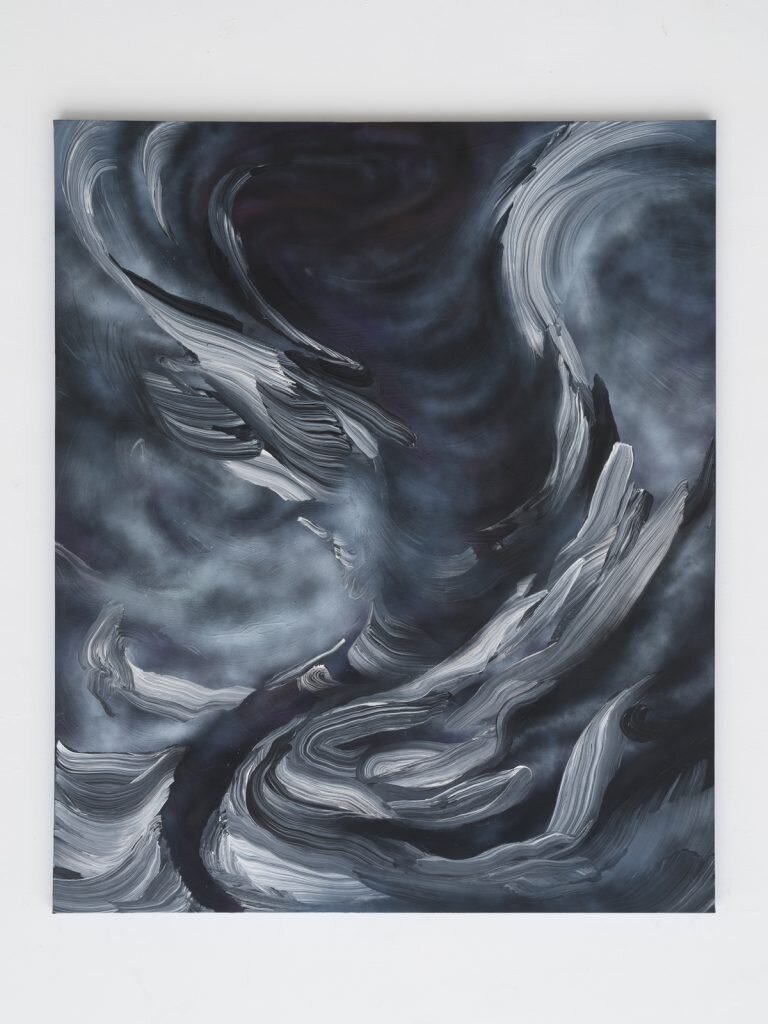Review: Manny Castro’s Stormscape at UTA Artist Space
California Art Review

Located on a quiet tree-lined street near the ornate Beverly Hills City Hall is the UTA Artist Space. Camouflaged amongst several small businesses, one enters the gallery with an especially warm greeting. Amongst the vaulted ceilings and impeccably painted white walls of the interior is Manny Castro’s solo exhibition Stormscape. Taking inspiration from the land and sea, Castro creates a multi-sensory environment for the audience with the heavy thematics of emigration, invisibility amongst communities of color, and the traumatic undertakings of Cuban exiles. The multidisciplinary approach of Castro’s practice cohesively weave together his figurative and abstract paintings that embody the tempestuous sea, and sculptures that three-dimensionally bring to life his painted figures.
The phrase “larger than life” could be used to interpret Castro’s large-scale sculptures. In Castro’s Coronation at Sea (2021), a solitary figure coated in a white impasto atop a raft of cowrie shells and barrels lays on its back in a contemplative state. Mindfully integrated, the viewer is made to wrestle with the experience of floating at sea with an unknown notion of what experiences will lie ahead. The use of mixed-media including unique materials such as burlap, synthetic hair and cowrie shells in Castro’s Guide (2021), bridge together the use of indigenous materials and relate back to the figurations in his paintings.
Referential to the figurations in the artist’s paintings, a primary focus of the sculptural figures are long legs attached to a smaller body. Castro’s sculptures in part relate to the fragmented human-like textile works by Magdalena Abakanowicz. Abakanowicz’s ‘Abakans’ were initially created out of organic matter and examine the dismemberment of identity, terror of war and the invisibility of the human body. While Castro’s figures have been constructed as solitary beings, altogether his works relate to the multiplicity and repetition articulated in Abakanowicz’s sculptural sets as in Agora, 2006.

Manny Castro. Even If You Can’t See Us, We Comin’, 2021. Oil and acrylic on canvas. 92 x 81 inches.
A continuum within Castro’s practice is the appearance of semi-abstracted figures coated with a heavy painted paste. Even If You Can’t See Us, We Comin’, 2021 shows two figures atop one another over a rushing stream of lines suggesting the rapid nature of water rushing below. The figure on the left appears to have a foot on the back of the figure on the right, an unsettling position. The title of the piece evokes change and responds to the layered narrative of immigration to the United States from Cuba, if not the world.
In Castro’s La Situación (2021), two figures appear in motion side by side amidst an atmospheric background relating to the sea in turmoil. The use of acrylic paint contrasts with the use of oil and creates a visceral sensation for the eyes in regards to texture. Hidden below the textural, white figurations, are underlying hints of vibrant hues of paint. The intentionality of these “spots” allows the viewer to articulate a semblance of body mass, identity and humanity. In this sense, Castro’s works correlate to John Baldessari’s interference effects, in which the viewer’s cognition and perception is put into conflict with the erasure of the human figuration. While Baldessari is most known for placing a dot on the faces of his characters, Castro alters the entire figure under a textural white molding paste to further his investigation of invisibility amongst people in marginalized communities.

Manny Castro. Turbulence, 2021. Oil and acrylic on canvas. 72 x 60 inches.
A series of abstract paintings within the larger body of Castro’s exhibition, including Undisclosed Voyage (2021), Turbulence (2021), and Magia in the Wind (2021), allows the viewer space to contemplate Castro’s multi-layered figurative works. Wispy strokes of oil paint atop the underlying acrylic surface provide an emotive interpretation of an aggravated weather pattern. A connection between J.M.W. Turner’s sublime seascapes such as Snow Storm (1842) can be dovetailed to Castro’s in how both artists replicate the intensity of the elements. While Turner investigates historical battles at sea, Castro addresses the battle between life and death; freedom and repression.
Manny Castro crafts an articulate response to the heavy subject of immigration to the United States in a time when the political atmosphere of the country parallels the difficulties experienced by migrants from the Cuban exodus. In this body of work Castro provides the viewer with a space to analyze where they themselves stand within the histories and the multi-generational repercussions of marginalization.
The exhibition Stormscape at UTA Artist Space closes on June 19th. For more information, please visit the gallery website.